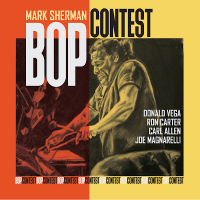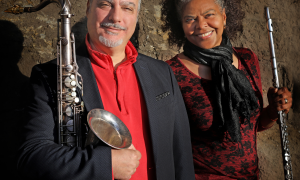When the Jazz Messengers returned to the studio on August 14th, they recorded seven more tracks. But the process was even tougher than a week earlier. All of the tracks that day required 30 or more takes, with the last one reaching 54 before a master was in the can. While many of these takes surely were false starts, the process was both draining and exhilarating from a creative standpoint. [Pictured: engineer Rudy Van Gelder, left, with producer Lion]
Listening to the playback, Lion realized he actually had enough material for two albums given the length of each track. He decided that both LPs would be made up of five tracks: a standard and four original compositions. Both albums would be named for songs that Blakey played frequently in clubs at the time, and each of those compositions would open side #1 of their respective LPs.
The albums Lion assembled from the two August sessions were A Night in Tunisia and Like Someone in Love, and both featured the same great group--trumpeter Lee Morgan, saxophonist Wayne Shorter, pianist Timmons, bassist Jymie Merritt and drummer Blakey. Blakey, Timmons and Merritt had been together since the fall of 1958, and except for a break in late 1959, when Walter Davis Jr. briefly replaced Timmons, the unit would remain intact until the spring of 1961. Wayne Shorter, of course, joined the group in late 1959.
While the album, A Night in Tunisia, is considered a Blakey classic, Like Someone in Love has received much less attention and praise. Yet all of the music on the two albums was recorded on the exact same dates with the exact same group. The big difference, to my ear, is that Lion appears to have grouped more of the rhythmically complex tracks on A Night in Tunisia and the more pensive ones on Like Someone in Love. Other than this difference, Lion likely jigsawed the two different albums, piecing them together based on which ones fit neatly into the 33 1/13-rpm format. The point here being that Like Someone in Love is a vastly overlooked masterpiece.
The other subtle difference between the two albums is Timmons, whose playing is so percussive and pretty on Like Someone in Love that he virtually becomes the third horn. His sensitive funky chord changes on the introductions to Like Someone in Love and Shorter's waltz-time composition, Sleeping Dancer Sleep On, alone are extraordinary.
At the time of this date, Blakey had already recorded the standard, Like Someone in Love, four times--first as a sideman on a Paul Bley session with Charles Mingus in 1953, and on live recordings, including one for Blue Note at New York's Cafe Bohemia. The Johnny Burke-Jimmy Van Heusen standard dates back to 1944. Dinah Shore introduced it in Belle of the Yukon, and the song was first recorded as an instrumental by Les Brown
that same year. Bing Crosby made the song a hit in 1945, and Frank Sinatra recorded it early in his Capitol period in 1953. The song was likely introduced to Blakey by Bley on his leadership date, and Blakey liked it so much that the standard became a regular feature in the Jazz Messengers' book.
Like Someone in Love's second track, Johnny's Blue, is the album's only Lee Morgan original. It opens with a bass solo, and the infectious minor-major blues line is somewhat similar to The Lion and the Wolff, which Morgan recorded four months earlier in April 1960 for his album, Lee-Way.
Noise in the Attic is by Shorter and winds up being a Blakey drum showcase piece. Even though Morgan and Shorter deliver blistering solos on the track, Timmons is the one who captivates your ear. His solo work stands out, building the heat with chorus after chorus.
Sleeping Dancer Sleep On, another Shorter original, is the record's highpoint for me. Timmons' introduction again is both lush and gospel-funky. On this ballad you begin to hear shades of Shorter's musical personality years before his seminal leadership recordings.
Giants, also by Shorter, closes the album and is a straight-ahead hard bop anthem, cooking the entire way. Timmons' solo again is exceptional, so much so that you can listen to it over and over again and hear something new each time.
Think of these albums as two sides of the same coin. If A Night in Tunisia is an extroverted date, Like Someone in Love is an introspective one--and an opportunity to hear Bobby Timmons in the very groove that suited him best.
JazzWax tracks: Like Someone in Love can be found as a download at iTunes and Amazon, or as a CD at online retailers. What I did is combine them both in the same iTunes folder and then shuffled the tracks so I don't know which song belongs to which album. The result is fascinating.
JazzWax video clip: Listen how pretty Bobby Timmons plays here on Yama, a Lee Morgan original from A Night in Tunisia. This clip is from the group's Japanese tour of 1961. According to Barbara J. Gardner's original album liner notes, Yama was named for the start of Morgan's wife's maiden name (Yamamoto).
This story appears courtesy of JazzWax by Marc Myers.
Copyright © 2026. All rights reserved.
























